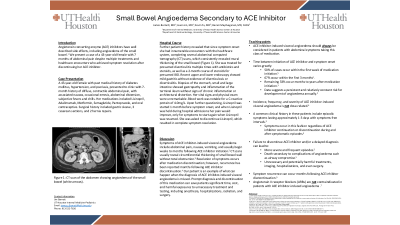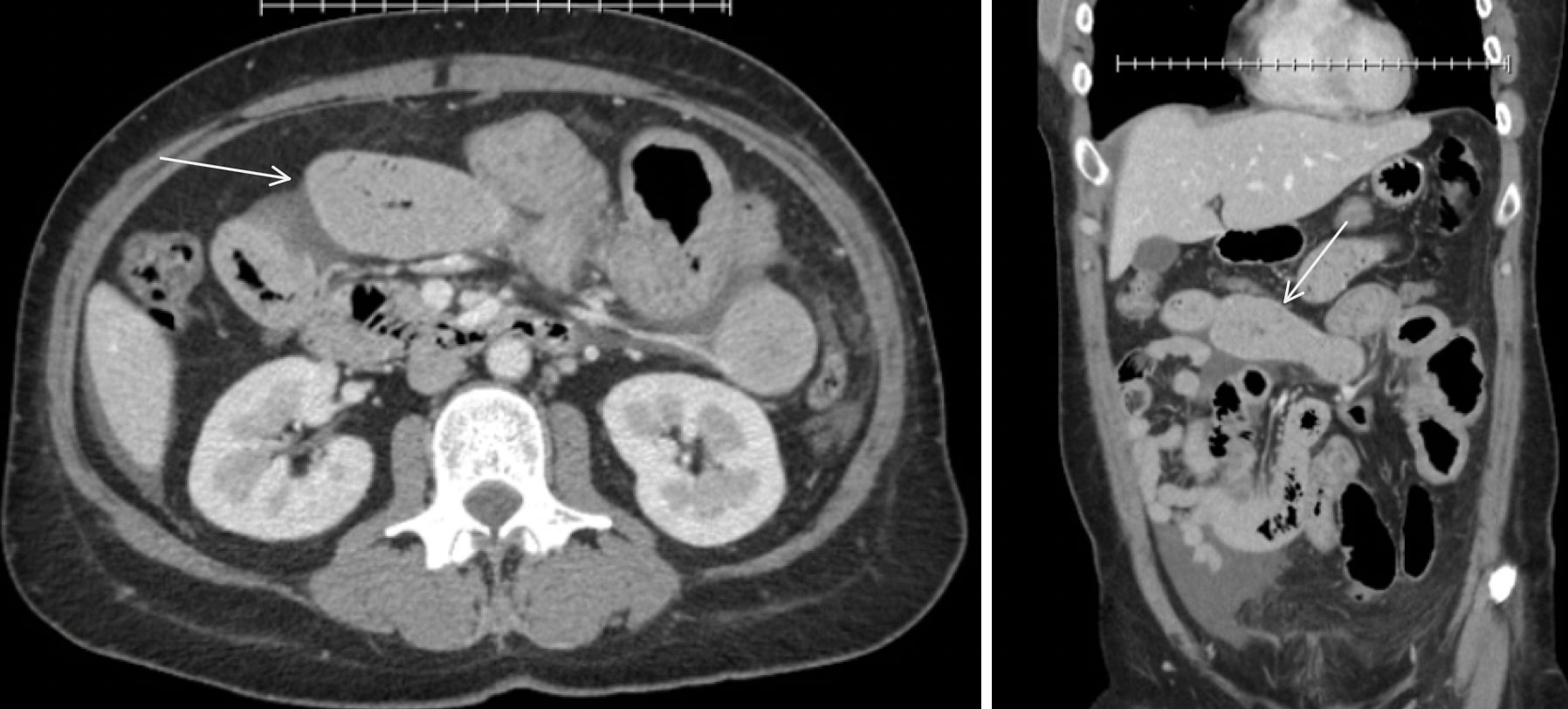Sunday Poster Session
Category: Small Intestine
P1535 - Small Bowel Angioedema Secondary to ACE Inhibitor
Sunday, October 27, 2024
3:30 PM - 7:00 PM ET
Location: Exhibit Hall E

Has Audio

James Barnett, MD
University of Texas at Houston
Houston, TX
Presenting Author(s)
James Barnett, MD1, Kevin K. Yu, MD2, Barani Mayilvaganan, MD, FACG2
1University of Texas at Houston, Houston, TX; 2University of Texas Health, McGovern Medical School, Houston, TX
Introduction: Angiotensin converting enzyme inhibitors (ACEi) have well described side effects, including angioedema of the small bowel. We present a case of a 43-year-old female with 7 months of abdominal pain despite multiple treatments and healthcare encounters who achieved symptom resolution after discontinuing her ACEi.
Case Description/Methods: A 43-year-old female with past medical history of diabetes mellitus, hypertension, and psoriasis, presented to clinic with 7-month history of diffuse, contractile abdominal pain, with associated nausea, occasional emesis, abdominal distension, subjective fevers and chills. Her medications included Lisinopril, Adalimumab, Metformin, Semaglutide, Pantoprazole, and oral contraceptive. Surgical history included gastric sleeve, 3 cesarean sections, and 2 hernia repairs. Since symptom onset she had innumerable encounters with the healthcare system, completing several abdominal computed tomography (CT) scans, which consistently revealed mural thickening of the small bowel (Figure 1). She was treated for presumed diverticulitis multiple times with antibiotics and steroids, as well as a 2-month course of steroids for presumed IBD. Recent upper and lower endoscopy showed mild gastritis without evidence of diverticulosis or diverticulitis. Biopsies of the stomach, small and large intestine showed gastropathy and inflammation of the terminal ileum without signs of chronic inflammation or architectural distortion. Her vital signs and physical exam were unremarkable. Blood work was notable for a C-reactive protein of 4.0mg/L. Upon further questioning, lisinopril was started 1 month before symptom onset, and when lisinopril was held during hospital admissions her pain would improve, only for symptoms to start again when lisinopril was resumed. She was asked to discontinue lisinopril, which resulted in complete symptom resolution.
Discussion: Symptoms of ACEi associated small bowel angioedema include abdominal pain, nausea, vomiting, and usually begin weeks to months following ACEi initiation. CT scans usually reveal circumferential thickening of small bowel wall without total obstruction. Resolution of symptoms occurs after medication discontinuation. Our patient is an example of what can happen when the diagnosis of ACEi associated small bowel angioedema is missed. Prompt diagnosis and discontinuation of this medication can save patients significant time, cost, and harmful exposures to unnecessary treatment and testing, including anesthesia, hospitalizations, and radiation.

Disclosures:
James Barnett, MD1, Kevin K. Yu, MD2, Barani Mayilvaganan, MD, FACG2. P1535 - Small Bowel Angioedema Secondary to ACE Inhibitor, ACG 2024 Annual Scientific Meeting Abstracts. Philadelphia, PA: American College of Gastroenterology.
1University of Texas at Houston, Houston, TX; 2University of Texas Health, McGovern Medical School, Houston, TX
Introduction: Angiotensin converting enzyme inhibitors (ACEi) have well described side effects, including angioedema of the small bowel. We present a case of a 43-year-old female with 7 months of abdominal pain despite multiple treatments and healthcare encounters who achieved symptom resolution after discontinuing her ACEi.
Case Description/Methods: A 43-year-old female with past medical history of diabetes mellitus, hypertension, and psoriasis, presented to clinic with 7-month history of diffuse, contractile abdominal pain, with associated nausea, occasional emesis, abdominal distension, subjective fevers and chills. Her medications included Lisinopril, Adalimumab, Metformin, Semaglutide, Pantoprazole, and oral contraceptive. Surgical history included gastric sleeve, 3 cesarean sections, and 2 hernia repairs. Since symptom onset she had innumerable encounters with the healthcare system, completing several abdominal computed tomography (CT) scans, which consistently revealed mural thickening of the small bowel (Figure 1). She was treated for presumed diverticulitis multiple times with antibiotics and steroids, as well as a 2-month course of steroids for presumed IBD. Recent upper and lower endoscopy showed mild gastritis without evidence of diverticulosis or diverticulitis. Biopsies of the stomach, small and large intestine showed gastropathy and inflammation of the terminal ileum without signs of chronic inflammation or architectural distortion. Her vital signs and physical exam were unremarkable. Blood work was notable for a C-reactive protein of 4.0mg/L. Upon further questioning, lisinopril was started 1 month before symptom onset, and when lisinopril was held during hospital admissions her pain would improve, only for symptoms to start again when lisinopril was resumed. She was asked to discontinue lisinopril, which resulted in complete symptom resolution.
Discussion: Symptoms of ACEi associated small bowel angioedema include abdominal pain, nausea, vomiting, and usually begin weeks to months following ACEi initiation. CT scans usually reveal circumferential thickening of small bowel wall without total obstruction. Resolution of symptoms occurs after medication discontinuation. Our patient is an example of what can happen when the diagnosis of ACEi associated small bowel angioedema is missed. Prompt diagnosis and discontinuation of this medication can save patients significant time, cost, and harmful exposures to unnecessary treatment and testing, including anesthesia, hospitalizations, and radiation.

Figure: Figure 1: CT scan of the abdomen showing angioedema of the small bowel (white arrows).
Disclosures:
James Barnett indicated no relevant financial relationships.
Kevin Yu indicated no relevant financial relationships.
Barani Mayilvaganan indicated no relevant financial relationships.
James Barnett, MD1, Kevin K. Yu, MD2, Barani Mayilvaganan, MD, FACG2. P1535 - Small Bowel Angioedema Secondary to ACE Inhibitor, ACG 2024 Annual Scientific Meeting Abstracts. Philadelphia, PA: American College of Gastroenterology.

